Recreation and Therapy in Urban Forests—The Potential Use of Sensory Garden Solutions
Abstract
1. Introduction
2. Materials and Methods
2.1. Study Area
2.2. Study Design
3. Results
3.1. Universal Design in Sensory Gardens—Potential Applications in Forests
3.2. Recreational Facilities in Forests—Desk Research of Applied Practices
4. Discussion
4.1. Sensory Gardens—A Creative Solution for People Not Only with Disabilities
- “A stand-alone area that focuses on a variety of sensory experiences ” (sensory trust) [7];
- “A composition designed so that extra-visual stimuli are used on purpose and at a greater intensity than usual” [23];
- A garden in which the influence of plants and other elements on certain senses is particularly emphasized (the garden of color, sound, smell, touch, and taste) [24];
- A garden, which refers to the idea that the garden can stimulate the senses (e.g., sight, taste, hearing, smell and touch) [25].
- Must be designed and created in a process with a set purpose;
- Is a closed whole, separate from the surrounding space;
- Stimulates all human senses;
- Focuses on non-visual experiences;
- Has vegetation, but also other elements, both natural and anthropogenic.
- Passive—by staying in a given place and experiencing the stimulation of the senses, by listening to birds singing, and feeling smells, wind, sunlight;
- Active—by performing physical work in the garden related to the maintenance of the garden: picking fruit and flowers, etc. The outdoor activities that most people like, such as sunbathing, games and fun, and walks, are interpreted differently. According to Hagedorn [28], this is passive use of the garden, while Gonzalez and Kirkevold [25] consider it an active form of using the space.
- “As a place of passive therapy—walking, watching nature, and being in green space, as well as aromatherapy, especially to stimulate immunity and control stress.
- As a place of application of other types of therapy loosely related to the garden—physical therapy, kinesiotherapy, and psychotherapy.
- As a place of active hortitherapy, using gardening for healing purposes, for treating depression, addictions, etc., as well as for activating elderly people with cognitive disorders that often occur at this age. It also works well for people with intellectual disabilities and emotional disorders.”
4.2. Barriers in Tourism and Recreation of People with Disabilities
4.3. Therapeutic Functions of Forests, Green Areas and Sensory Gardens
4.4. Recreational Development of Forests and Green Areas
5. Conclusions
Author Contributions
Funding
Institutional Review Board Statement
Informed Consent Statement
Data Availability Statement
Conflicts of Interest
References
- Mazurek-Kusiak, A. Charakterystyka popytu na rekreację konną w polskich lasach. Sylwan 2018, 162, 785–792. [Google Scholar] [CrossRef]
- Thompson Coon, J.; Boddy, K.; Stein, K.; Whear, R.; Barton, J.; Depledge, M.H. Does Participating in Physical Activity in Outdoor Natural Environments Have a Greater Effect on Physical and Mental Wellbeing than Physical Activity Indoors? A Systematic Review. Environ. Sci. Technol. 2011, 45, 1761–1772. [Google Scholar] [CrossRef] [PubMed]
- Smith, R.W. Leisure of disabled tourist. Barriers to participation. Ann. Tour. Res. 1987, 14, 376–389. [Google Scholar] [CrossRef]
- Urban and Peri-Urban Forestry. Available online: http://www.fao.org/forestry/urbanforestry/87025/en/ (accessed on 26 June 2021).
- Van Elegem, B.; Embo, T.; Muys, B.; Lust, N. A methodology to select the best locations for new urban forests using multicriteria analysis. For. Int. J. For. Res. 2002, 75, 13–23. [Google Scholar] [CrossRef]
- Spring, J.A. Design of evidence-based gardens and garden therapy for neurodisability in Scandinavia: Data from 14 sites. Neurodegener. Dis. Manag. 2016, 6, 87–98. [Google Scholar] [CrossRef] [PubMed]
- Sensory Trust. Sensory Garden Design Advice. 2003. Available online: http://www.sensorytrust.org.uk/information/factsheets/sensory-garden-4.html (accessed on 25 May 2018).
- Wajchman-Świtalska, S.; Zajadacz, A.; Lubarska, A. Therapeutic functions of forests and green areas with regard to the universal potential of sensory gardens. Environ. Sci. Proc. 2021, 3, 8. [Google Scholar] [CrossRef]
- Hussein, H.; Omar, Z.; Ishak, S.A. Sensory garden for an inclusive society. Asian J. Behav. Stud. 2016, 1, 33–43. [Google Scholar] [CrossRef]
- Souter-Brown, G.; Hinckson, E.; Duncan, S. Effects of a sensory garden on workplace wellbeing: A randomised control trial. Landsc. Urban Plan. 2021, 207, 103997. [Google Scholar] [CrossRef]
- Kucks, A.; Hughes, H. Creating a Sensory Garden for Early Years Learners: Participatory Designing for Student Wellbeing. In School Spaces for Student Wellbeing and Learning; Hughes, H., Franz, J., Willis, J., Eds.; Springer: Singapore, 2019. [Google Scholar] [CrossRef]
- Hussein, H.; Abidin, N.M.N.Z.; Omar, Z. Engaging Research and Practice in Creating for Outdoor Multi-sensory Environments: Facing Future Challenges. Procedia—Soc. Behav. Sci. 2013, 105, 536–546. [Google Scholar] [CrossRef][Green Version]
- Zajadacz, A. Changes in leisure time in the large cities in Poland caused by the COVID-19 pandemic: The types of activities and the amount of leisure time. In Seria Turystyka i Rekreacja—Studia i Prace; Zajadacz, A., Ed.; Bogucki Wydawnictwo Naukowe: Poznań, Poland, 2021; Volume 23, p. 136. [Google Scholar]
- Grima, N.; Corcoran, W.; Hill-James, C.; Langton, B.; Sommer, H.; Fisher, B. The importance of urban natural areas and urban ecosystem services during the COVID-19 pandemic. PLoS ONE 2020, 15, e0243344. [Google Scholar] [CrossRef]
- Venter, Z.; Barton, D.; Gundersen, V.; Figari, H.; Nowell, M. Urban Nature in a Time of Crisis: Recreational Use of Green Space Increases during the COVID-19 Outbreak in Oslo, Norway. Preprint. Available online: https://osf.io/preprints/socarxiv/kbdum/ (accessed on 30 September 2021).
- Mackenzie, S.H.; Goodnow, J. Adventure in the Age of COVID-19: Embracing Microadventures and Locavism in a Post-Pandemic World. Leis. Sci. 2020, 43, 62–69. [Google Scholar] [CrossRef]
- Jakubowski, M.; Szczepańska, M.; Ogonowska-Chrobrowska, H. Ogrody i Ścieżki Zmysłów w Procesie Rekreacji i Edukacji Przyrodniczo Leśnej Osób Niewidzących i Niedowidzących; Specjalny Ośrodek Szkolno-Wychowawczy dla Dzieci Niewidomych w Owińskach: Owińskach, Poland, 2018. [Google Scholar]
- Zajadacz, A.; Lubarska, A. Ogrody Sensoryczne Jako Uniwersalne Miejsca Rekreacji Dostosowane do Potrzeb Osób Niewidomych w Kontekście Relacji Człowiek-Środowisko; Boguski Wydawnictwo Naukowe: Poznań, Poland, 2020; p. 180. [Google Scholar]
- Zajadacz, A.; Lubarska, A. Sensory gardens in the context of promoting well-being of people with visual impairments in the outdoor sites. Int. J. Spa Wellness 2019, 2, 3–17. [Google Scholar] [CrossRef]
- Zajadacz, A.; Lubarska, A. Sensory gardens as places for outdoor recreation adapted to the needs of people with visual impairments. Studia Perieget. 2020, 30, 25–43. [Google Scholar] [CrossRef]
- Nowacka, W.Ł. Projektowanie leśnej przestrzeni turystycznej z punktu widzenia niepełnosprawnego użytkownika. Studia I Mater. Cent. Edukac. Przyr.-Leśnej 2010, 26, 30–39. [Google Scholar]
- Kacprzyk, W. Turystyka w Lasach Państwowych. Tom I. Las bez Barier—Obiekty Terenowe; Ośrodek Rozwojowo-Wdrożeniowy Lasów Państwowych w Bedoniu: Nowy Bedoń, Poland, 2015; p. 95. [Google Scholar]
- Pawłowska, K. Ogród sensoryczny. Pr. Kom. Kraj. Kult. 2008, 9, 143–152. [Google Scholar]
- Latkowska, M.J.; Miernik, M. Therapeutic gardens—Places of passive and active green therapy. Archit. Czas. Tech. 2012, 8A, 245–250. [Google Scholar]
- Gonzalez, M.T.; Kirkevold, M. Clinical use of sensory gardens and outdoor environments in Norwegian nursing homes: A cross-sectional e-mail survey. Issues Ment. Health Nurs. 2015, 36, 35–43. [Google Scholar] [CrossRef]
- Hussein, H. Sensory gardens. Access Des. 2009, 118, 13–17. [Google Scholar]
- Zawiślak, G. Hortiterapia jako narzędzie wpływające na poprawę zdrowia psychicznego i fizycznego człowieka. Ann. UMSC 2015, 25, 21–31. [Google Scholar]
- Hagedorn, R. Environment and opportunity: The potential of horticulture for enriching the life of disabled people. Clin. Rehabil. 1988, 2, 249–251. [Google Scholar] [CrossRef]
- Haupt, P.; Skalna, B.; Rekuć, M.; Mikołajska, I.; Furlaga, Z.; Kusińska, E.; Gajewski, Ł. Modelowa Koncepcja Ścieżki Moto-sensorycznej. 2019. Available online: https://www.rops.krakow.pl/pliki/MIIS/Innowacje_za__aczniki/Ko__cowa_wersja_koncepcji_projektu_architektonicznego.pdf (accessed on 1 June 2021).
- Łobożewicz, T. Wpływ turystyki i rekreacji na przywracanie sprawności psychofizycznej osób o specjalnych potrzebach. In Postęp w Turystyce na Rzecz Osób o Specjalnych Potrzebach; Ślężyński, J., Petryński, W., Eds.; Polskie Stowarzyszenie Osób Niepełnosprawnych: Kraków, Poland, 1995; p. 46. [Google Scholar]
- Zajadacz, A. Turystyka Osób Niesłyszących—Ujęcie Geograficzne; Bogucki Wydawnictwo Naukowe: Poznań, Poland, 2012; p. 227. [Google Scholar]
- Tabęcki, R. Ograniczenia i perspektywy rozwoju turystyki osób niepełnosprawnych w Polsce i w wybranych krajach europejskich. In Krajoznawstwo i Turystyka Osób Niepełnosprawnych; Midura, F., Żbikowski, J., Eds.; Wydawnictwo PWSZ im. Papieża Jana Pawła II: Biała Podlaska, Poland, 2005; p. 125. [Google Scholar]
- Lubarska, A. Przegląd klasyfikacji barier i ograniczeń dla turystyki osób z niepełnosprawnością. In Seria Turystyka i Rekreacja Studia i Prace; Młynarczyk, Z., Zajadacz, A., Eds.; Bogucki Wydawnictwo Naukowe: Poznań, Poland, 2018; pp. 57–72. [Google Scholar]
- McKercher, B.; Darcy, S. Re-conceptualizing barriers to travel by people with disabilities. Tour. Manag. Perspect. 2018, 26, 59–66. [Google Scholar] [CrossRef]
- Doimo, I.; Masiero, M.; Gatto, P. Forest and wellbeing: Bridging medical and forest research for effective forest-based initiatives. Forests 2020, 11, 791. [Google Scholar] [CrossRef]
- Roe, J.J.; Thompson, C.W.; Aspinall, P.A.; Brewer, M.J.; Duff, E.I.; Miller, D.; Mitchell, R.; Clow, A. Green Space and Stress: Evidence from Cortisol Measures in Deprived Urban Communities. Int. J. Environ. Res. Public Health 2013, 10, 4086–4103. [Google Scholar] [CrossRef]
- Chiesura, A. The role of urban parks for the sustainable city. Landsc. Urban Plan. 2004, 68, 129–138. [Google Scholar] [CrossRef]
- Antonelli, M.; Barbieri, G.; Donelli, D. Effects of forest bathing (shinrin-yoku) on levels of cortisol as a stress biomarker: A systematic review and meta-analysis. Int. J. Biometeorol. 2019, 63, 1117–1134. [Google Scholar] [CrossRef] [PubMed]
- Kotera, Y.; Richardson, M.; Sheffield, D. Effects of Shinrin-Yoku (Forest Bathing) and Nature Therapy on Mental Health: A Systematic Review and Meta-analysis. Int. J. Ment. Health Addict. 2020. [Google Scholar] [CrossRef]
- Farrow, M.R.; Washburn, K.A. Review of Field Experiments on the Effect of Forest Bathing on Anxiety and Heart Rate Variability. Glob. Adv. Health Med. 2019. [Google Scholar] [CrossRef]
- Lee, I.; Bang, K.S.; Kim, S.; Choi, H.; Lee, B.; Song, M. Effect of Forest Program on Atopic Dermatitis in Children—A Systematic Review. J. Korean Inst. For. Recreat. 2016, 20, 1–13. [Google Scholar] [CrossRef][Green Version]
- Lee, I.; Choi, H.; Bang, K.S.; Kim, S.; Song, M.; Lee, B. Effects of forest therapy on depressive symptoms among adults: A systematic review. Int. J. Environ. Res. Public Health 2017, 14, 321. [Google Scholar] [CrossRef]
- Rosa, C.D.; Larson, L.R.; Collado, S.; Profice, C.C. Forest therapy can prevent and treat depression: Evidence from meta-analyses. Urban For. Urban Green. 2020, 57, 126943. [Google Scholar] [CrossRef]
- Krzymowska-Kostrowicka, A. Geoekologia Turystyki i Wypoczynku; Wydaw. Naukowe PWN: Warsaw, Poland, 1997; pp. 1–239. [Google Scholar]
- Loureiro, G.; Rabaça, M.A.; Blanco, B.; Andrade, S.; Chieira, C.; Pereira, C. Urban versus rural environment--any differences in aeroallergens sensitization in an allergic population of Cova da Beira, Portugal? Eur. Ann. Allergy Clin. Immunol. 2005, 37, 187–193. [Google Scholar] [PubMed]
- Eriksson, L.; Nordlund, A. How is setting preference related to intention to engage in forest recreation activities? Urban For. Urban Green. 2013, 12, 481–489. [Google Scholar] [CrossRef]
- Dwyer, J.; Schroeder, H.; Gobster, P. The significance of urban trees and forests: Toward a deeper understanding of values. J. Arboric. 1991, 17, 276–284. [Google Scholar]
- Germann-Chiari, C.; Seeland, K. Are urban green spaces optimally distributed to act as places for social integration? Results of a geographical information system (GIS) approach for urban forestry research. For. Policy Econ. 2004, 6, 3–13. [Google Scholar] [CrossRef]
- Miyazaki, Y.; Park, B.J.; Lee, J. Nature therapy, in designing our future. In Local Perspectives on Bioproduction, Ecosystems and Humanity; Osaki, M., Braimoh, A., Nakagami, K., Eds.; United Nations University Press: Tokyo, Japan, 2011; Volume 2011, pp. 407–412. [Google Scholar]
- Song, C.; Ikei, H.; Kobayashi, M.; Miura, T.; Li, Q.; Kagawa, T.; Kumeda, S.; Imai, M.; Miyazaki, Y. Effects of viewing forest landscape on middle-aged hypertensive men. Urban For. Urban Green. 2017, 21, 247–252. [Google Scholar] [CrossRef]
- Hansen, M.M.; Jones, R.; Tocchini, K. Shinrin-yoku (forest bathing) and nature therapy: A state of the art review. Int. J. Environ. Res. Public Health 2017, 14, 851. [Google Scholar] [CrossRef]
- Wen, Y.; Yan, Q.; Pan, Y.; Gu, X.; Liu, Y. Medical empirical research on forest bathing (Shinrin-yoku): A systematic review. Environ. Health Prev. Med. 2019, 24, 70. [Google Scholar] [CrossRef]
- Bell, S.L.; Foley, R.; Houghton, F.; Maddrell, A.; Williams, A.M. From therapeutic landscapes to healthy spaces, places and practices: A scoping review. Soc. Sci. Med. 2018, 196, 123–130. [Google Scholar] [CrossRef]
- Fernee, C.R.; Gabrielsen, L.E. Wilderness therapy. In Outdoor Therapies: An Introduction to Practices, Possibilities, and Critical Perspectives, 1st ed.; Harper, N.J., Dobud, W.W., Eds.; Routledge: New York, NY, USA, 2020; pp. 69–80. [Google Scholar]
- Konijnendijk, C.C.; van den Bosch, M.; Annerstedt, M.; Nielsen, A.B.; Maruthaveeran, S. Benefits of Urban Parks—A Systematic Review; A Report for IFPRA; Copenhagen & Alnarp. 2013. Available online: https://www.theparksalliance.org/benefits-of-urban-parks-a-systematic-review-a-report-for-ifpra-published-in-january-2013/ (accessed on 10 June 2021).
- Coldwell, D.F.; Evans, K.L. Visits to Urban Green-Space and the Countryside Associate with Different Components of Mental Well-Being and Are Better Predictors than Perceived or Actual Local Urbanisation Intensity. Landsc. Urban Plan. 2018, 175, 114–122. [Google Scholar] [CrossRef]
- Westphal, J.M. Hype, Hyperbole, and Health: Therapeutic site design. In Urban Lifestyles: Spaces, Places People; Benson, J.F., Rowe, M.H., Eds.; Brookfield, A.A. Balkema: Rotterdam, The Netherlands, 2000. [Google Scholar]
- Murat, K. Factors affecting the planning and management of urban forests: A case study of Istanbul. Urban For. Urban Green. 2020, 54, 126739. [Google Scholar] [CrossRef]
- Uchwała Sejmu Rzeczypospolitej Polskiej z dnia 1 Sierpnia 1997 r. Karta Praw Osób Niepełnosprawnych (M.P .Nr 50, poz. 475). Available online: http://isap.sejm.gov.pl/isap.nsf/DocDetails.xsp?id=WMP19970500475 (accessed on 10 June 2021).
- Krzeptowska-Moszkowicz, I.; Moszkowicz, Ł.; Porada, K. Evolution of the Concept of Sensory Gardens in the Generally Accessible Space of a Large City: Analysis of Multiple Cases from Kraków (Poland) Using the Therapeutic Space Attribute Rating Method. Sustainability 2021, 13, 5904. [Google Scholar] [CrossRef]
- Ward Thompson, C. Activity, Exercise and the Planning and Design of Outdoor Spaces. J. Environ. Psychol. 2013, 34, 79–96. [Google Scholar] [CrossRef]
- Rosenberger, R.S.; Bergerson, T.R.; Kline, J.D. Macrolink-ages between Health and Outdoor Recreation: The Role of Parks and Recreation Providers. J. Park Recreat. Admi. 2009, 27, 8–20. [Google Scholar]
- Irvine, K.; Warber, S.; Devine-Wright, P.; Gaston, K. Understanding Urban Green Space as a Health Resource: A Qualitative Comparison of Visit Motivation and Derived Effects among Park Users in Sheffield, UK. Int. J. Environ. Res. Public Health 2013, 10, 417–442. [Google Scholar] [CrossRef] [PubMed]
- Kolimenakis, A.; Solomou, A.D.; Proutsos, N.; Avramidou, E.V.; Korakaki, E.; Karetsos, G.; Maroulis, G.; Papagiannis, E.; Tsagkari, K. The Socioeconomic Welfare of Urban Green Areas and Parks: A Literature Review of Available Evidence. Sustainability 2021, 13, 7863. [Google Scholar] [CrossRef]
- Tsunetsugu, Y.; Lee, J.; Park, B.; Tyrväinen, L.; Kagawa, T.; Miyazaki, Y. Physiological and psychological effects of viewing urban forest landscapes assessed by multiple measurements. Landsc. Urban Plan. 2013, 113, 90–93. [Google Scholar] [CrossRef]
- Bonilla-Duarte, S.; Gómez-Valenzuela, V.; Vargas-de la Mora, A.L.; García-García, A. Urban Forest Sustainability in Residential Areas in the City of Santo Domingo. Forests 2021, 12, 884. [Google Scholar] [CrossRef]
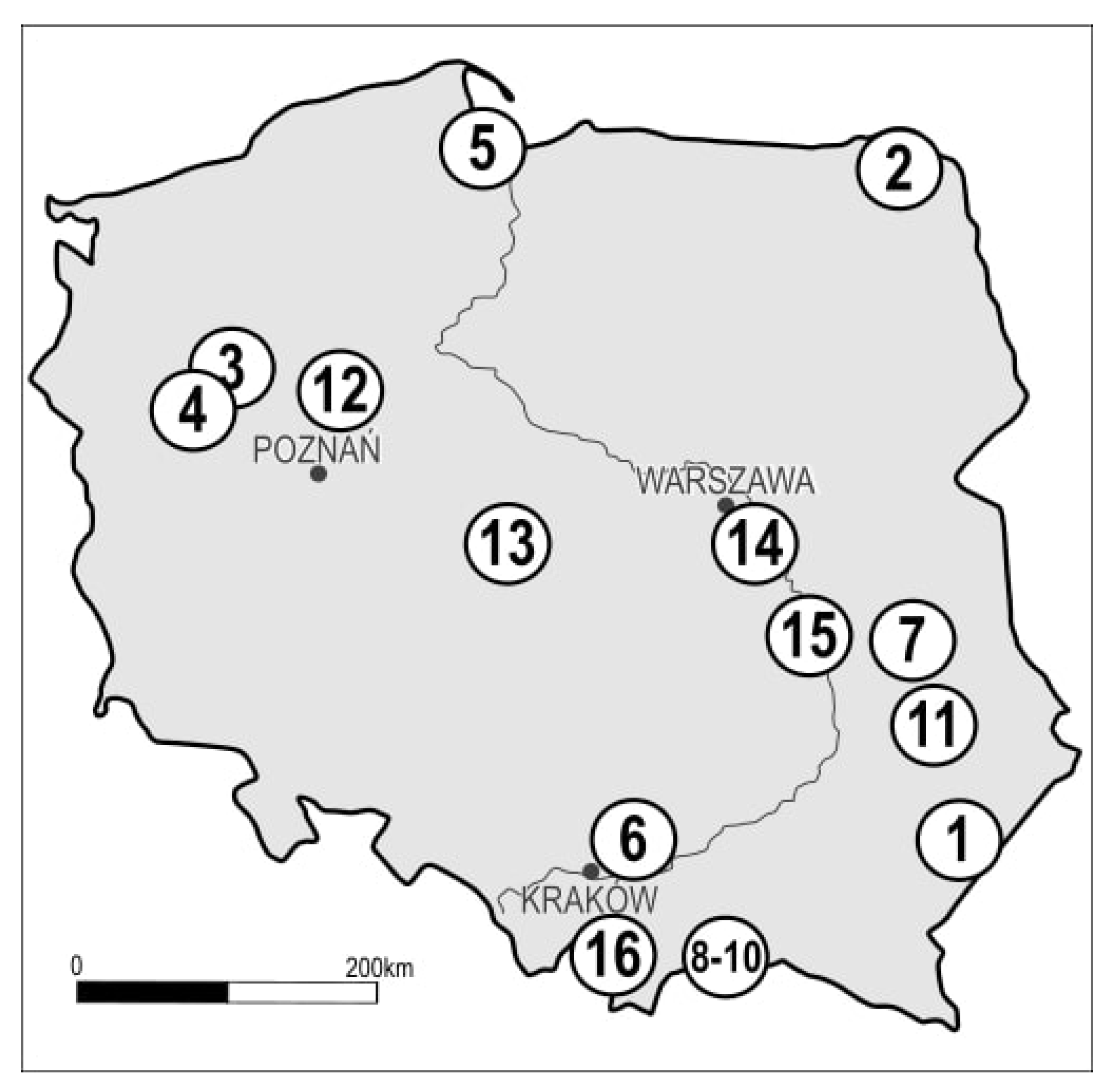
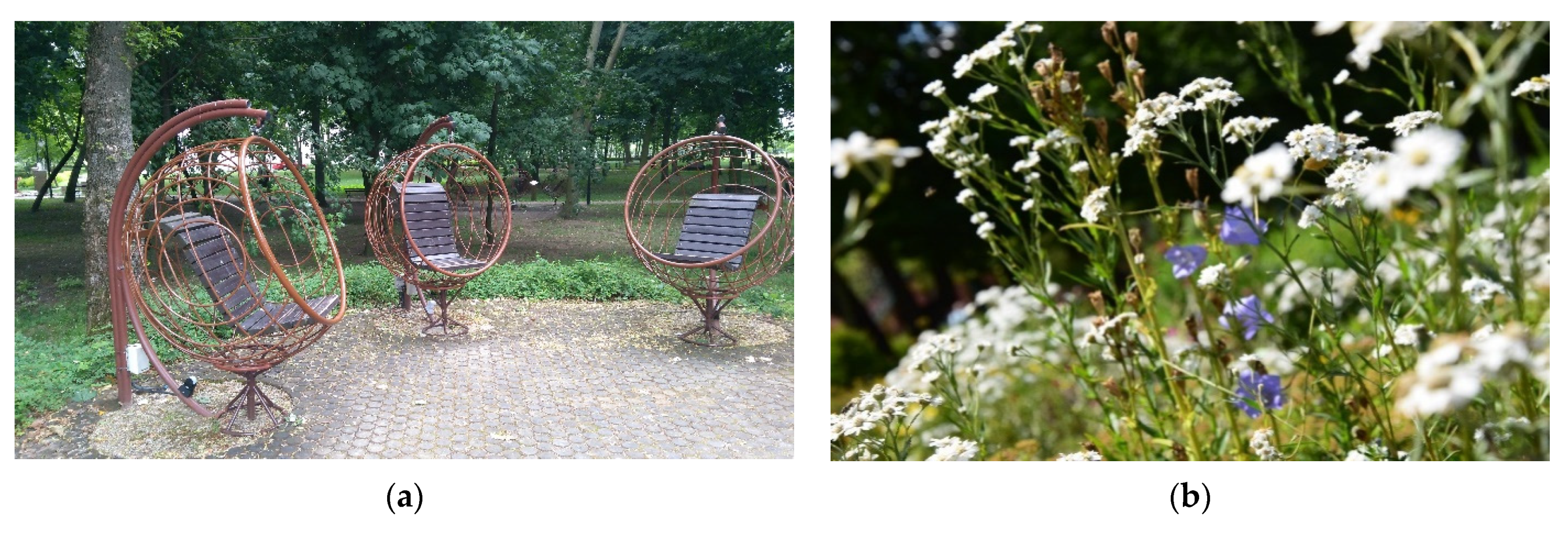

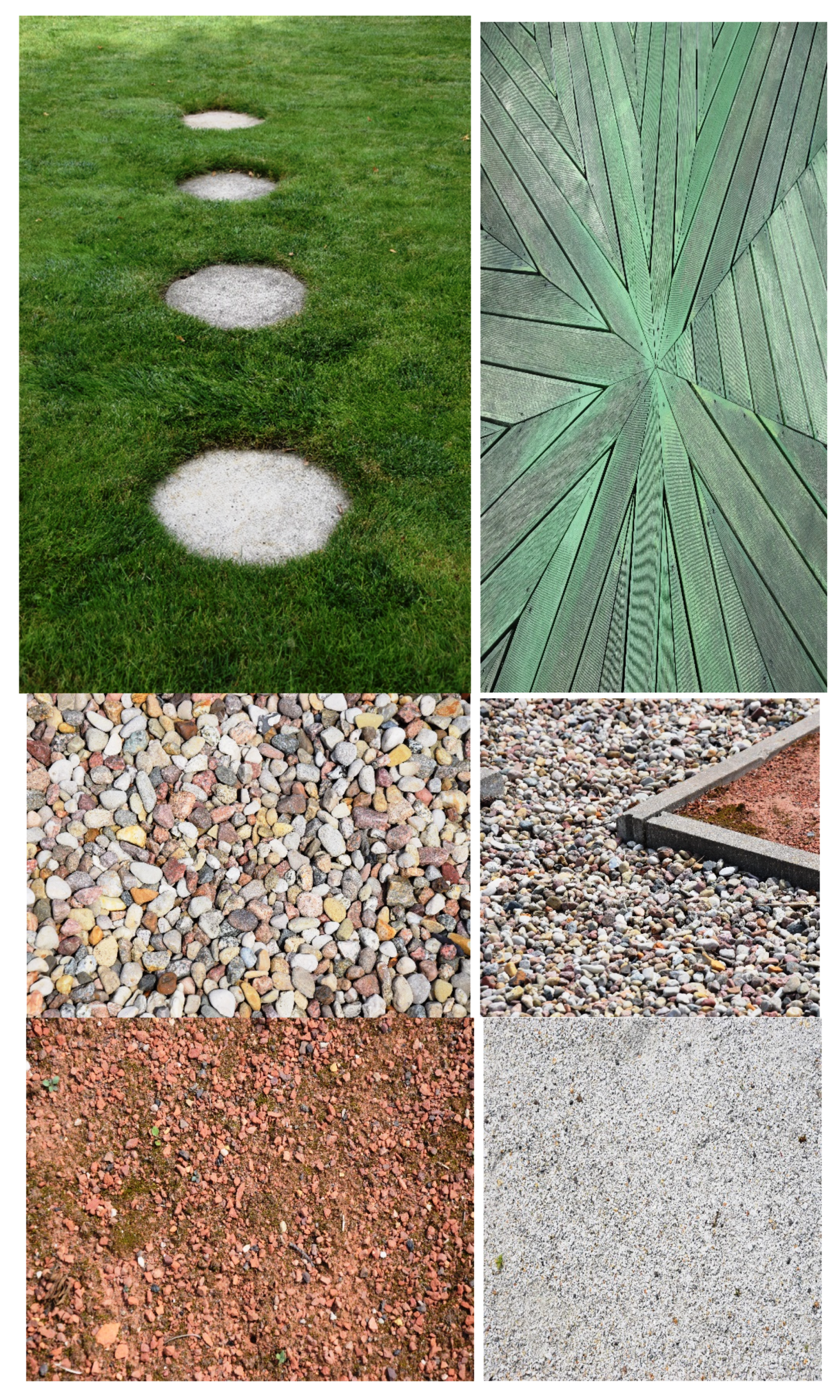
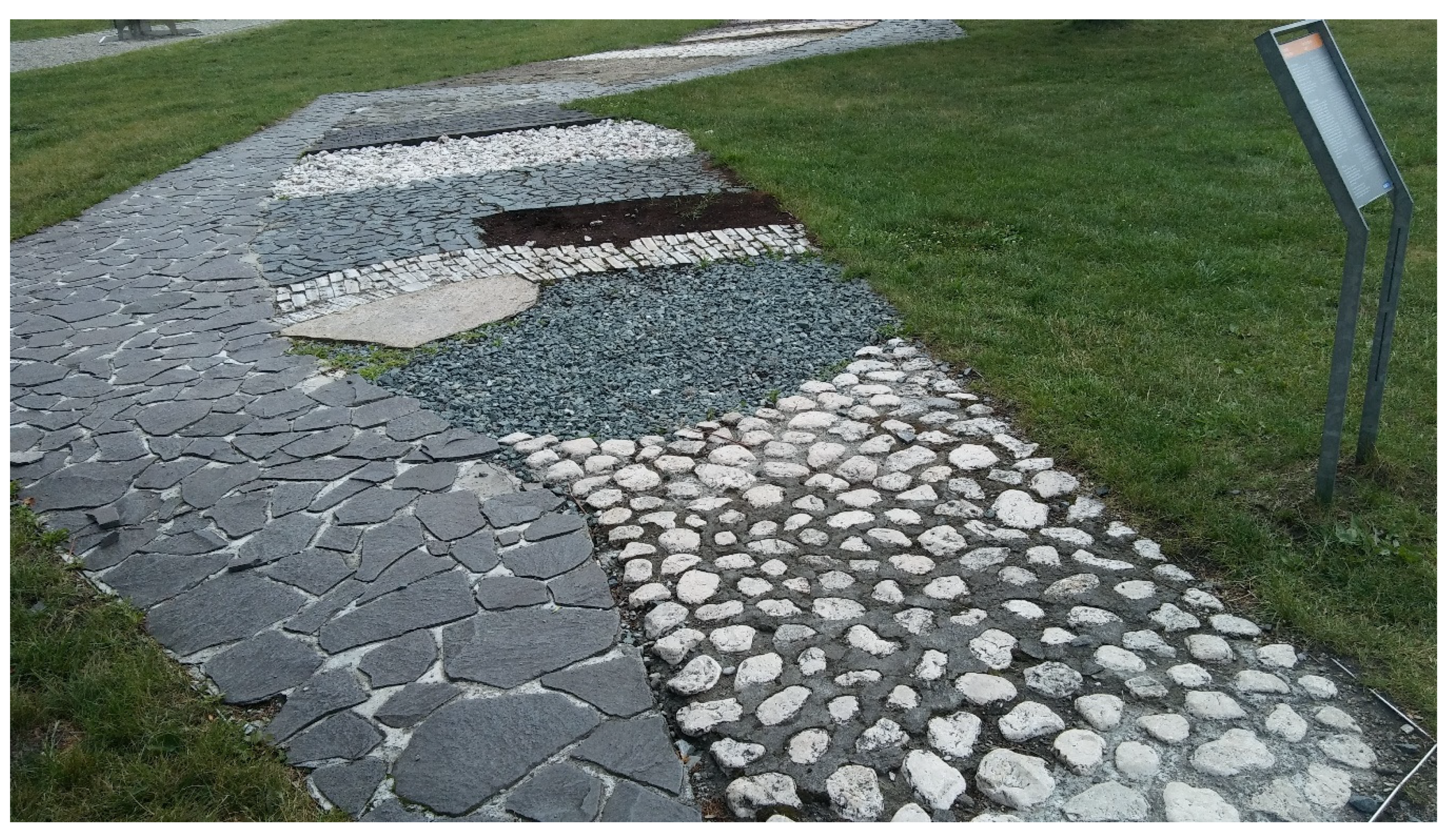
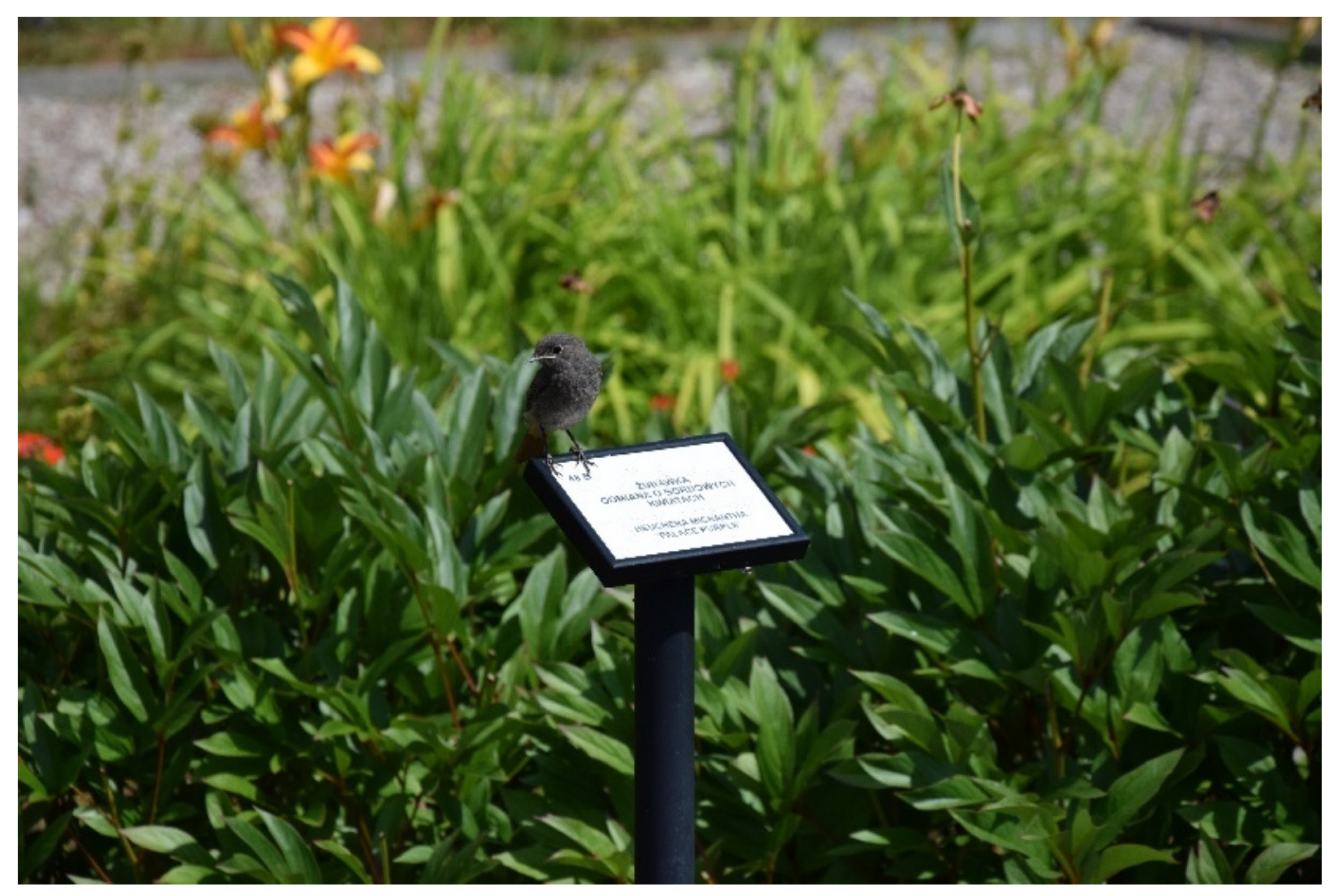
| Location of the Sensory Garden | Type of Environment | Setting | Coordinates |
|---|---|---|---|
| 1. Bolestraszyce | Rural | Arboretum | 49.81767470425935 22.85963205188485 |
| 2. Bród Nowy | Rural | Educational and recreational school garden | 54.13310633220314 22.87824015575021 |
| 3. Bucharzewo | Rural | Forest educational garden | 52.67929426341419 16.09764799617132 |
| 4. Chorzępowo | Rural | Forest educational garden | 52.69849904750158 16.09713467457603 |
| 5. Gdańsk-Oliwa | Urban | City park | 54.414561388875526 18.56869532665728 |
| 6. Kraków | Urban | Commercial science park | 50.07044044210445 19.997914018768107 |
| 7. Lublin | Urban | University botany garden | 51.26596084591114 22.51659339812219 |
| 8. Muszyna (Ogrody Biblijne) | Urban | Commercial educational and spiritual garden | 49.35895057351808 20.901974361122278 |
| 9. Muszyna (Ogrody Magiczne) | Urban | City garden | 49.345923233427236 20.884421943659394 |
| 10. Muszyna (Ogrody Sensoryczne) | Urban | City park | 49.347567900990136 20.88853191824345 |
| 11. Osmolice | Rural | Private garden | 51.579692111665814 22.06933798840454 |
| 12. Owińska | Rural | Educational and recreational school garden | 52.511276130254345 16.97413330331303 |
| 13. Poddębice | Urban | City park | 51.88970856853506 18.952417769156217 |
| 14. Powsin | Urban | Botany garden of a scientific institution | 52.10628212831032 21.095847051626784 |
| 15. Trzcianki | Rural | Commercial theme park | 51.36551912934566 21.910141838449825 |
| 16. Zawoja | Rural | National park education area | 49.6120128648685 19.518040540235628 |
| Feature | Sensory Gardens and Paths | ∑/% | |||||||||||||||
|---|---|---|---|---|---|---|---|---|---|---|---|---|---|---|---|---|---|
| a | b | ||||||||||||||||
| 1 | 2 | 3 | 4 | 5 | 6 | 7 | 8 | 9 | 10 | 11 | 12 | 13 | 14 | 15 | 16 | ||
| 1. Scents (Fot.1) | x | x | x | x | x | x | x | x | x | x | x | x | x | x | x | x | 16/100 |
| 2. Clear path layout (Fot. 2) | x | x | x | x | x | x | x | x | x | - | - | - | x | x | x | x | 13/81 |
| 3. Diversified surface of path surface (Fot. 3) | x | x | x | x | - | x | - | x | - | x | x | - | x | x | x | - | 11/69 |
| 4. Advice from others | x | x | x | x | x | x | x | x | - | - | - | x | - | - | - | x | 10/63 |
| 5. Waypoints described in Braille (Fot.4) | x | x | - | - | - | - | - | - | - | - | x | - | - | x | - | x | 5/31 |
| 6. Convex plans of communication routes | x | - | x | x | - | - | - | - | - | - | - | - | - | x | - | - | 4/25 |
| 7. Audible information | x | x | - | - | - | - | - | - | - | - | - | - | - | - | - | x | 3/19 |
| 8. Tactile walking surface indicators | - | - | - | - | - | - | - | - | - | - | - | - | - | - | - | - | 0/0 |
| 9. Spatial models | - | - | - | - | - | - | - | - | - | - | - | - | - | - | - | - | 0/0 |
| 10. Applications in mobile devices | - | - | - | - | - | - | - | - | - | - | - | - | - | - | - | - | 0/0 |
| Infrastructure | Basic Parameters | Additional Info |
|---|---|---|
| One-way paths |
|
|
| Bidirectional paths |
| - |
| Longitudinal slope of routes |
|
|
| Cross slope of routes |
|
|
| Avoidance spots on routes (without infrastructure) |
|
|
| Stairs |
|
|
| Handrails |
|
|
Publisher’s Note: MDPI stays neutral with regard to jurisdictional claims in published maps and institutional affiliations. |
© 2021 by the authors. Licensee MDPI, Basel, Switzerland. This article is an open access article distributed under the terms and conditions of the Creative Commons Attribution (CC BY) license (https://creativecommons.org/licenses/by/4.0/).
Share and Cite
Wajchman-Świtalska, S.; Zajadacz, A.; Lubarska, A. Recreation and Therapy in Urban Forests—The Potential Use of Sensory Garden Solutions. Forests 2021, 12, 1402. https://doi.org/10.3390/f12101402
Wajchman-Świtalska S, Zajadacz A, Lubarska A. Recreation and Therapy in Urban Forests—The Potential Use of Sensory Garden Solutions. Forests. 2021; 12(10):1402. https://doi.org/10.3390/f12101402
Chicago/Turabian StyleWajchman-Świtalska, Sandra, Alina Zajadacz, and Anna Lubarska. 2021. "Recreation and Therapy in Urban Forests—The Potential Use of Sensory Garden Solutions" Forests 12, no. 10: 1402. https://doi.org/10.3390/f12101402
APA StyleWajchman-Świtalska, S., Zajadacz, A., & Lubarska, A. (2021). Recreation and Therapy in Urban Forests—The Potential Use of Sensory Garden Solutions. Forests, 12(10), 1402. https://doi.org/10.3390/f12101402






